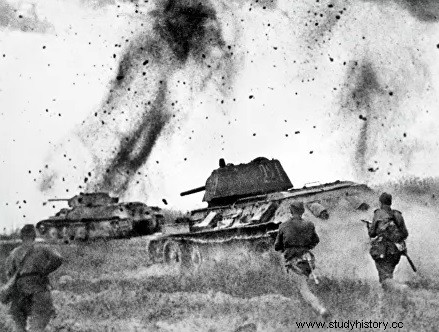 The Battle of Kursk , which took place in western Russia from July 5 to 13, 1943, is a turning point in World War II. Involving more than 2 million men and more than 3,000 Russian and German armor, it is considered the greatest tank battle in history . The last major offensive attempted by the Nazis on the eastern front, it cost Hitler the disappearance of more than 100,000 men and irreparable losses to his armored divisions, which until then had remained invincible. With its victory the Soviet Union proved to the whole world that the German armored weapon (Panzerwaffe ) was not invincible. She acquired there the serenity necessary for the great liberating offensives of 1944.
The Battle of Kursk , which took place in western Russia from July 5 to 13, 1943, is a turning point in World War II. Involving more than 2 million men and more than 3,000 Russian and German armor, it is considered the greatest tank battle in history . The last major offensive attempted by the Nazis on the eastern front, it cost Hitler the disappearance of more than 100,000 men and irreparable losses to his armored divisions, which until then had remained invincible. With its victory the Soviet Union proved to the whole world that the German armored weapon (Panzerwaffe ) was not invincible. She acquired there the serenity necessary for the great liberating offensives of 1944.
The background to the Battle of Kursk
In the spring of 1943, the Hitler Reich's strategic options were limited. Faced with the Western allies, since the Casablanca conference (January 1943), it is no longer possible to hope to negotiate. Stalin who may have saved his regime at Stalingrad, is in a strong position. On a material and industrial level, Germany faces the specter of a war of attrition that it cannot win. She is therefore condemned to play her way in a new offensive.
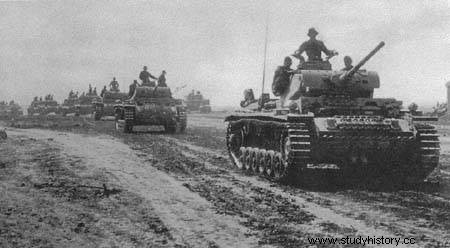 The latter for obvious reasons (80% of German means are concentrated in the east) can only intervene against the Soviets. It is first of all a question of erasing the trauma of the catastrophe of the battle of Stalingrad, but also of reassuring the allies of Germany in difficulty (whether it is Italy, Hungary or from Romania). With a new victorious offensive in the east, Hitler also intends to bleed white a Soviet Union that he considers weakened by two years of war and thus constitute a strategic reserve able to protect "Fortress Europe" (Festung Europe ).
The latter for obvious reasons (80% of German means are concentrated in the east) can only intervene against the Soviets. It is first of all a question of erasing the trauma of the catastrophe of the battle of Stalingrad, but also of reassuring the allies of Germany in difficulty (whether it is Italy, Hungary or from Romania). With a new victorious offensive in the east, Hitler also intends to bleed white a Soviet Union that he considers weakened by two years of war and thus constitute a strategic reserve able to protect "Fortress Europe" (Festung Europe ).
Factor likely to reinforce Berlin's optimism, the real start of the war economy (the famous Totaler Krieg from the speech of Goebbels of February 43) organized by Speer . This notably made it possible to reconstitute the German offensive weapon par excellence:the armored troops. Under the leadership of General Guderian (became inspector general of armored vehicles), it was reinforced and reorganized, drawing lessons from the clashes with Soviet armored formations (and their famous T-34). Hitler places great hopes in new materials such as the Tiger tanks or the Panther tank (which however suffer from many faults on the mechanical level), able to face the most powerful Soviet armored vehicles.
Once the decision had been made to return to the offensive in the east in 1943, it was still necessary to determine where. A cursory examination of the map of the front at this time offers a quick and obvious answer:at Kursk. Indeed there is a rectangular salient of about 180km (north-south) by 140 (east-west), the result of the Soviet winter offensives. In the center, the city of Kursk, an important railway junction, offers an excellent starting point for an attack by the Red Army, whether from the south (Kharkov) or the north (Orel).
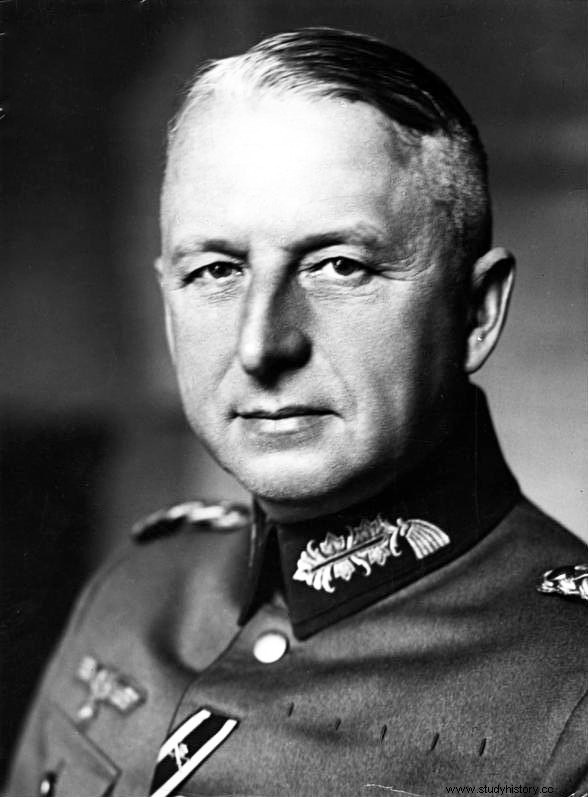 By attacking Kursk in a sort of preemptive manner, the German General Staff intends operationally to deprive Stalin of its best units (Central Front and Voronezh Front) and shorten its front by almost 280 km (a saving of some twenty divisions). Given the shape of the salient, Operation Citadel take the classic form of a pincer attack. The southern pincer is the responsibility of the army group of Marshal Von Manstein .
By attacking Kursk in a sort of preemptive manner, the German General Staff intends operationally to deprive Stalin of its best units (Central Front and Voronezh Front) and shorten its front by almost 280 km (a saving of some twenty divisions). Given the shape of the salient, Operation Citadel take the classic form of a pincer attack. The southern pincer is the responsibility of the army group of Marshal Von Manstein .
Manstein, who enjoyed Hitler's trust due to his ability to overturn the most hopeless situations, fielded impressive formations on paper. On the left the 4th Armored Army of Hermann Hoth :10 divisions (including the elite of armored and mechanized formations such as Hausser's SS armored corps ), 200,000 men and about 1,100 armour. On the right the Kempf army detachment which notably aligns 3 armored divisions. The northern pincer is the sole responsibility of the 9th army of General Model . Popular with his men, but particularly brutal Model, who is an expert in the defensive, lines up 21 divisions (including 7 armored and mechanized) or 335,000 men and nearly 900 armour.
Due to the temperament of the two leaders concerned and the disproportion of their forces (and the air support that a Luftwaffe already reduced by the lack of fuel could offer), it appears quickly that most of the offensive effort will be supported by Manstein's units. Unlike Model, the conqueror of Sevastopol believes that even the fortifications and the depth of the Soviet defensive system will not be able to stop his tanks. An unfounded optimism, due in large part to the shortcomings of German intelligence…
Stalin's Citadel
A recurrent fact of the German-Soviet war, German military intelligence strongly underestimated the power of the Red Army. On the other hand, if the Soviets are masters in the art of disinformation, they are aware of German intentions thanks to partisans and a sophisticated listening system. They will thus be able to set up a formidable defensive system. From March 1943, troops and civilians (more than 300,000!) from the Kursk region established eight lines of defense at a depth of 300 km.
Trenches, minefields, strongpoints are supposed to channel German attack formations, which it will be up to armored reserves to destroy. Everything is concealed using proven maskirovka techniques. which will explain that the Germans will never be aware of the defensive potential deployed against them. There is no doubt that if Model had known that her 9 e army would have to face 80,000 mines, 2,800 artillery pieces and 537 multiple rocket launchers, he would have thought twice before launching the assault.
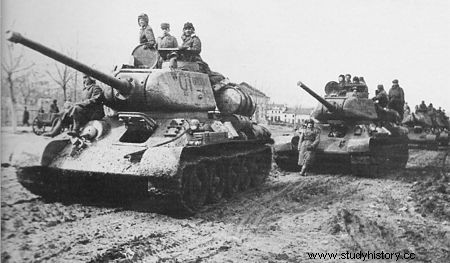 It is clear that Stalin; which now leaves more latitude to the Soviet generals, has allocated considerable means to the defense of the Kursk salient. It is because the master of the USSR intends to make this salient a point of fixation for the best German units, so that his own offensives can develop serenely (primarily Operation Kutusov to Orel). To the north facing Model General Rokossovski (of Polish origin and victim of the 1937 purges) leads the center front. A brilliant officer, he has several armies to carry out his task (the Soviet armies and their divisions are smaller than their German equivalents) totaling 700,000 men and 1,800 armored vehicles (not all T34s far from it, however). ). If Model is to break through in two days, Rokossoskvi has time on his side and the possibility of resorting to the reserves wisely accumulated in his rear by Stalin.
It is clear that Stalin; which now leaves more latitude to the Soviet generals, has allocated considerable means to the defense of the Kursk salient. It is because the master of the USSR intends to make this salient a point of fixation for the best German units, so that his own offensives can develop serenely (primarily Operation Kutusov to Orel). To the north facing Model General Rokossovski (of Polish origin and victim of the 1937 purges) leads the center front. A brilliant officer, he has several armies to carry out his task (the Soviet armies and their divisions are smaller than their German equivalents) totaling 700,000 men and 1,800 armored vehicles (not all T34s far from it, however). ). If Model is to break through in two days, Rokossoskvi has time on his side and the possibility of resorting to the reserves wisely accumulated in his rear by Stalin.
Facing Manstein is the Voronezh Front of young general Vatutine (42 years old) who is aligned. A native of the region and knowing his adversary well, Vatoutine has 6 armies (two of which will not be attacked and will act as a reserve). The whole represents 625,000 men and 1,700 armored vehicles. Not enough to prevent Manstein's offensive from deploying, but enough to prepare a deadly counter-attack... Indeed Vatoutine, like Rokossovski, knows that in the long term he can benefit from the help of two accumulated reserve groups (including the Front de la Steppe) behind the salient. In order to coordinate their action, the STAVKA (Soviet High Command) will dispatch to Kursk its two best officers, the brutal Joukov and calm Vassilyevsky . A powerful duo that complements each other perfectly, quite capable of competing with their German opponents.
Two weeks to change the course of the war
After several postponements, partly due to Hitler's desire to equip his armored formations with the most recent equipment (Panther tanks among others) the date of the start of the operation Citadelle is fixed for July 4, 1943. Having benefited from a careful preparation of 4 months, it begins at 4 p.m. with the entry into the running of the Stukas of the Luftwaffe. It is a question of preparing the thrust of the 4th Armored Army of Hoth which opens the ball on the ground.
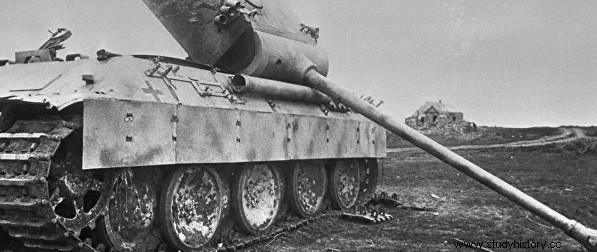 Faced with the brutality of the mechanized assault Vatutin was not surprised and reacted calmly. The Soviet defense which is based on heights is relentless. The Soviet counter battery fire is precise, the minefields deadly. In the air the planes with the red star greatly hinder a Luftwaffe handicapped by the lack of fuel. To make matters worse for Hoth, the 200 Panthers that make up its spearhead are victims of repeated mechanical problems. On the evening of July 6, its breakthrough only reached a few kilometers, where in 1941 it would have reached several dozen.
Faced with the brutality of the mechanized assault Vatutin was not surprised and reacted calmly. The Soviet defense which is based on heights is relentless. The Soviet counter battery fire is precise, the minefields deadly. In the air the planes with the red star greatly hinder a Luftwaffe handicapped by the lack of fuel. To make matters worse for Hoth, the 200 Panthers that make up its spearhead are victims of repeated mechanical problems. On the evening of July 6, its breakthrough only reached a few kilometers, where in 1941 it would have reached several dozen.
For Model, the situation is even worse. The leader of the 9 e The army cautiously opted for the Soviet method:assault by infantry, then exploitation by armored vehicles (while Hoth rushes forward with his armored vehicles at the head… German style). However, late in the night of the 4th to the 5th, the setting up of these units was made complicated by the activity of an admirably well-informed Soviet artillery (by deserters among others). As in the south, the resistance of the Red Army was vigorous and the minefields considerably delayed the German advance. On the evening of July 5, the 9 th army has driven a corner 20km wide by 7 deep, at the cost of nearly 10% of its potential (the equivalent of the reserves that can reach it). It is too expensive and too little, knowing that the 6 Rokossovski is already launching its counter offensive. The assault lacked coordination and represented a bloodbath for the Soviets, but the 9 e army loses another 24 hours. Enough for Rokossovski to learn from his failure and reorganize his system.
The Battle of Kursk, the last of the great German offensives in the east
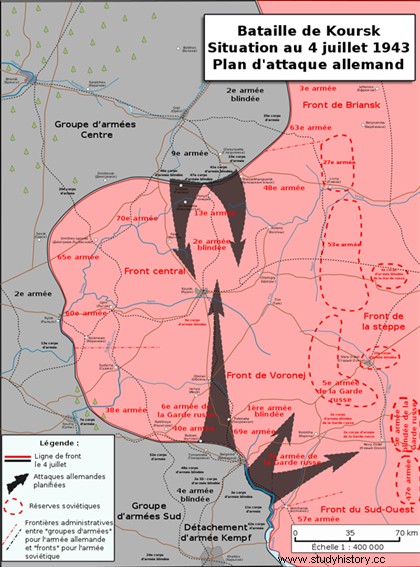 South July 6 finally brings good news to Germans. The 2
th
SS armored corps (Hausser) has the chance to strike in a relatively undefended sector and breaks through in the direction of Prokhorovka . On the 7th, the breakthrough spread to the other corps of the Hoth army and the 2
e
Soviet line of defense is everywhere crossed. A real crisis is playing out within the general staff of Vatoutine which obtains from Stalin, a massive sending of formations of reserves and in particular the 5
th
Romistrov Guards Tank Army (coming from Voronezh). Despite Vatutin's concerns, Stalin had some reasons to consider the continuation of the operations with optimism. The Kempf army detachment has not had the same success as the armored army of Hoth and to the north Model hardly advances any more.
South July 6 finally brings good news to Germans. The 2
th
SS armored corps (Hausser) has the chance to strike in a relatively undefended sector and breaks through in the direction of Prokhorovka . On the 7th, the breakthrough spread to the other corps of the Hoth army and the 2
e
Soviet line of defense is everywhere crossed. A real crisis is playing out within the general staff of Vatoutine which obtains from Stalin, a massive sending of formations of reserves and in particular the 5
th
Romistrov Guards Tank Army (coming from Voronezh). Despite Vatutin's concerns, Stalin had some reasons to consider the continuation of the operations with optimism. The Kempf army detachment has not had the same success as the armored army of Hoth and to the north Model hardly advances any more.
It must be said that the 9 e The army bore the full brunt of the wear and tear on its formations, which were increasingly exposed to the Soviet air force. On July 9, Model, who was unable to maneuver and was locked up in a logic of frontal assault, also gave in the strongest sectors of Rokossovski's device. A defense specialist, Model quickly understood that he could not break through. Worried about his northern flank (the final preparations for Operation Kutusov are beginning to be spotted by the Germans), his superior Marshal Von Kluge (Army Group Center) orders him to begin a withdrawal from July 12. The Soviets then won half of the Battle of Kursk.
So it's up to Von Manstein to make the difference. He is optimistic, certainly because he ignores the importance of the reserves that the Soviets will throw in his way. From the 9th to the 12th due to the disposition of the Soviet forces, Hoth ended up directing his effort towards Prokhorovka, the road to which seemed to have been cleared by the SS Panzers. He intends to annihilate Vatoutine's armored reserve there, which would open the way to Kursk. However, he will be surprised, just like Hausser and his SS, by the assault of the Tanks of the Guard of Romistrov .
On July 12, on an 8km front on either side of the local railway line, the fine flower of Soviet and German armored weapons will clash. Extremely tough fight, Prokhorovka, magnified by Soviet propaganda, if according to the most recent research is not the "swan song of the Panzerwaffe is, however, very bad news for Manstein. The SS tanks certainly obtained a measured defensive victory there, but they suffered heavy losses and were unable to capture their objective, the Prokhorovka railway junction.
The 13th Hitler summons Manstein and Kluge to his HQ at Rastenburg in East Prussia. Hausser's failure has certainly worried him, but he's even more concerned about other news. 3 days earlier the Western allies landed in Sicily and captured Syracuse. Given the lack of effectiveness of the Italian defense, the island can be considered lost in the short term.
Hitler therefore had no choice but to build up a reserve army to secure the southern flank of Fortress Europe. The latter must rely on politically secure elements:Hausser's SS. Deprived of its spearhead, Hoth would therefore no longer be able to make significant progress. Citadel is therefore suspended and stops definitively on the 17th. The Führer has lost his bet and the initiative on the Eastern front. All that remains for the German armies is to retreat...
A turning point in the Second World War

The German failure to seize Kursk and destroy the Center and Voronezh Fronts there represents a serious setback for the Hitler Reich. The eastern front has not been shortened and the constitution of a strategic reserve can only be done to the detriment of the operational situation against the Red Army. Worse, Operation Citadel, despite the losses it entails for the Red Army (255,000 men, against 60,000 Germans) will not prevent the Soviets from launching Operation Kutusov on July 12.
In Kursk the myth of the invincibility of German armor is dead once and for all. It is with a new spirit and reinforced by its confidence in its own abilities in mechanized combat, that the Red Army begins the summer of 1943. Victory can no longer escape it.
Bibliography
- Kursk:The Forty Days that Ruined the Wehrmacht (July 5 - August 20, 1943) by Jean Lopez. Economica, 2008.
- Kursk:The greatest tank battle in the history of François de Lannoy. Heimdal, 1998.
- Erich Von Manstein:Hitler's Strategist by Benoît Lemay. Tempus, 2010.
- The Battle of Kursk by Yves Buffetaut. History and Collection, 2000.
